
Although engineers usually think of compressive strength as the most important property of concrete, concrete for slabs on ground is different. According to ACI PRC-302.1-15, for slabs on ground the most important properties are workability, setting time, finishability, and shrinkage. Strangely enough, too high a concrete strength could result in more cracking.
Applications for concrete slabs on ground include industrial floors, big box stores, and warehouses. The functionality of these floors requires flatness and levelness—that is, a smooth, level surface—and durability under heavy traffic.
Curling
Concrete slabs on ground have a tendency to curl. Instead of lying flat, the edges and corners rise above the subbase. When the concrete is relatively young, the self weight of the slab may be too much to support, causing the concrete to crack. But even if it survives this stage without cracking, the additional weight of forklifts driving over the cantilevered portions of the slab may crack it.
Curling occurs because the concrete dries from the top surface. That causes it to shrink, and because the top shrinks more than the bottom, the slab curls. If the top surface is cooler than the bottom, the difference in thermal contraction compounds this effect.
Concrete for slabs on ground
This is why it’s important to design the concrete to shrink as little as possible. For this purpose the aggregate is key. If you have a choice about it, use a hard aggregate that will restrain the shrinkage. Optimizing the aggregate grading is essential so that it fills as much space as possible. We like to proportion the concrete using the aggregate suspension method, as it’s an efficient way to fill the space while maintaining good workability. Use the largest maximum size of aggregate you can—up to 1/3 the thickness of the slab. And use a coarse sand to limit the fines in the aggregates.
Limit the amount of cementitious materials—especially the really fine ones like silica fume. Don’t make the mistake of believing that stronger concrete is better. Normally we make concrete stronger by adding more cementitious material while keeping the water content the same. In slabs, it’s better to limit the water content and specify just enough strength to do the job. The load-bearing capacity of the slab is related more to the thickness than the strength in any case.
Try to avoid entraining air in the concrete. Most industrial floors require a hard troweled finish, which is not compatible with air entrainment. Air entrainment is necessary if the slab must be durable to cycles of freezing and thawing, however.
Construction tips
If you’re constructing an interior slab, make sure the construction sequence protects the slab from freezing so it doesn’t need air entrainment. That is, enclose the space before placing the slab. That also protects it from wind, rain, and rapid changes in temperature.
It’s a good idea to measure the air content. Engineers often think of testing for air content when they’ve specified air entrainment, but in a slab on ground it’s important to verify that the air is not there. Up to 3% air may be entrapped in concrete, but anything over 3% is grounds for rejecting the load. Even without testing, though, experienced concrete finishers should be able to see whether the concrete has entrained air. They just need to know it shouldn’t be there.
Joint spacing should conform to ACI PRC-360-10. Timing is critical for sawing the joints—early enough that the concrete doesn’t crack first, yet late enough to prevent raveling. Alternatively, you could use a shrinkage-compensating concrete, or post-tension the slab. That way you can eliminate joints altogether.
You also want to minimize moisture- and temperature gradients. To limit the moisture gradient, place a vapor barrier under the slab. Otherwise the relative humidity at the bottom will always be 100%. Moist cure the top of the slab as long as possible. To limit the temperature gradient, keep the placement temperature low. That way the concrete won’t have to cool as much. Cool concrete also has a lower water demand, so you won’t be tempted to add water.
We can help you specify your slab on ground—or develop a concrete mixture that meets someone else’s specification.
